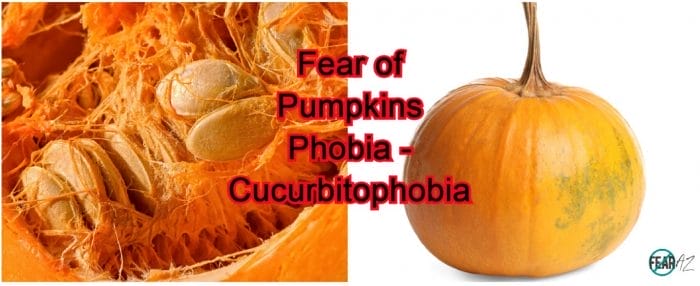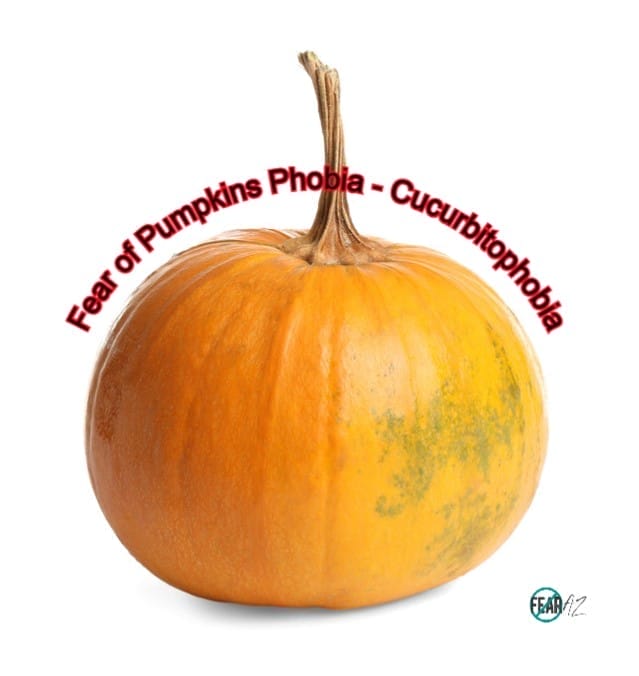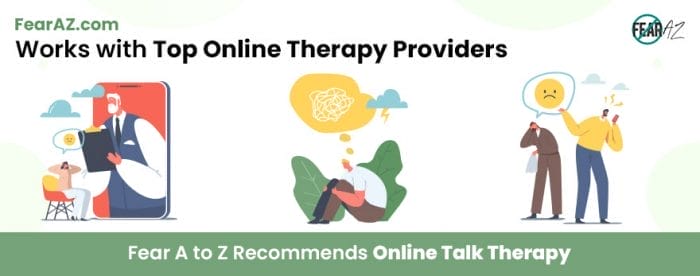Share This Article
Pumpkins are one of the oldest domesticated plants. They’re a first cousin to squash and a symbol of the fall season. Fall celebrations wouldn’t be complete without the ever-familiar pumpkins.
But there’s another side to these cheerful, orange globes. One that causes excessive fear or even disgust in some. This fear is known as cucurbitophobia.
Cucurbitophobia can leave a person trembling with panic or nausea when it comes to pumpkins. Does this sound like you?
If you’ve ever wondered if it’s possible to master your fear of pumpkins, read on for more.
What Is Cucurbitophobia?
Cucurbitophobia is also known as the fear of pumpkins or disgust/fear of pumpkin guts. It is derived from the Greek word cucurbita meaning pumpkin family, and phobos meaning fear.

Cucurbitophobia is a specific phobia, meaning it’s a fear directed at a certain object or situation. This fear may limit a person’s daily life and may affect their mental health.
Is Cucurbitophobia a Phobia of Fear or Disgust?
Do you dislike Halloween or Thanksgiving because you fear you may come in contact with pumpkins ? Do you tremble at the mere thought of a pumpkin patch or Jack O’Lantern? Perhaps you have a garden, but you avoid growing pumpkins because of this phobia. Your anxiety may even lead to panic attacks. These are hallmarks of cucurbitophobia.
Cucurbitophobics may persistently worry about future events that involve pumpkins. This is called anticipatory anxiety. The sufferer may also experience flight-or-fight mode when encountering pumpkins or similar plants.
Cucurbitophobia may make someone fear pumpkins so much that they resort to avoidance behaviors. In severe cases, they don’t only avoid situations or objects with pumpkins but also the thoughts about them.
Even when a person is not physically in contact with pumpkins, their brain may react the same either way. This is because fear is a physical response to our patterns of thinking—the thoughts we attach to big, orange pumpkins, whether it be the sight, smell, or touch.
If you have cucurbitophobia, you may show the following behaviors:
- Refusal to be in situations with pumpkins
- Avoiding gardens and farms
- Do everything possible to avoid holidays with pumpkins
Each cucurbitophobia sufferer is different. The images, videos, sounds, and words they associate with pumpkins are also different.
What Causes Cucurbitophobia?
Do you specifically remember what started your fear of pumpkins?
Cucurbitophobia causes are the same as that of other specific phobias. At times, there may not be an apparent cause that generated the fear. But it is largely one’s genetic predisposition to anxiety disorders and traumatic events that work in tandem to develop cucurbitophobia.
Genetics
People who have a family history of anxiety disorders or specific phobias are more likely than others to develop cucurbitophobia. They may have a genetic predisposition to it. However, this alone is rarely a reason for a phobia to develop. But if genetics are combined with a traumatic event, it may develop into a phobia.
Traumatic Events
Some people may have experienced in their past a traumatic event involving pumpkins. For example, kids may develop aversions towards pumpkins because of a scary pumpkin event. This can be reinforced with Halloween and how pumpkins are used during the holiday. Others may have an adverse reaction to the smell of pumpkins or the appearance of the inner seed and pulp. This can manifest in the form of disgust.
What Are the Symptoms of Cucurbitophobia?
Symptoms of cucurbitophobia may depend on the underlying cause, the individual, and the intensity of their fear. It can range from a mild uneasiness to feeings of panic. The closer you get to pumpkins, the more anxious you may become.
Cucurbitophobia symptoms are quite similar to that of other specific phobias.
Physical Symptoms
- Dizziness
- Shaking
- Heart palpitations
- Breathlessness
- Chest pain
- Sweating
- Nausea
- Stomach problems
- Numbness or tingling
- Hot or cold flashes
- Feeling unsteady
- Feeling of choking
Psychological Symptoms
- Obsessive thoughts
- Difficulty concentrating
- Flashes of negative images of decaying matter
- Fear of fainting
- Fear of losing control
- Withdrawal
- Anger
- Sadness
- Guilt
Self-Help Guide to Treating Cucurbitophobia
When cucurbitophobia interferes with daily tasks, treating it becomes necessary. Don’t worry. There are several cucurbitophobia treatment options out there. Some can be done on your own while others invove professional therapy.
Here are some popular self-help techniques to curb the anxiety related to cucurbitophobia.
Meditate
Meditation brings you back to the present. Since your attention is on all of your senses, you can let go of anxiety.
Practice Yoga
Yoga is essentially meditation but with movement. With yoga, one concentrates on breathing and lets go of unnecessary feelings. In the process, you let go of the stress and anxiety caused by cucurbitophobia.
Regular Exercise
Cardio workouts like jogging, swimming, and aerobics are recommended for those with phobias and anxiety. You finish relaxed because your body releases the happy hormones. These help counteract the negative emotions brought about by a phobia. Exercising regularly keeps you in a good mood and eases the negative thoughts related to cucurbitophobia.
Journaling
Writing what you are anxious about can significantly reduce your stress. Vent your stress on paper. And don’t forget to jot down the things you are grateful for. This will remind you of positive things and stir happy feelings.
Professional Help for Cucurbitophobia
If self-help techniques fail to make a difference, seek help from a professional. It will take you to the root of the issue, so you’ll be able to better understand the cause. Ask a licensed therapist or doctor to verify your diagnosis. Although there’s not one specific treatment that guarantees an instant or complete cure, there are some techniques that work to ease the symptoms of most phobias.
Exposure Therapy
Exposure therapy works to desensitize you to pumpkins and/or their decaying matter bit by bit until you are no longer anxious.
Cognitive Behavioral Therapy (CBT)
Cognitive behavioral therapy (CBT) aims to bring rationality to your thought processes. CBT tries to replace negative thoughts with positive ones.
More Treatment Methods for Cucurbitophobia
- Talk therapy
- Dialectical behavioral therapy
- Mindfulness-based stress reduction
- Neuro-linguistic programming (NLP)
- Eye movement desensitization and reprocessing (EMDR)
Your psychologist will suggest a treatment option based on your specific condition.
How to Cope with Cucurbitophobia
How long can you avoid coming into contact with pumpkins? Avoidance is a quick fix, but does it work? No. And here’s why. When you rely on avoidance behaviors, your fear of pumpkins may worsen with time. It then starts hurting you by limiting your life.
You can regain control of your emotions. To do this, you’ll need to work to change how you react to body stimuli.
Here are some tips that will help you cope:
- Take a deep breath and relax. It may seem hard, but it works.
- Prepare your body for stressful situations by doing meditation and yoga.
- Gradually expose yourself to your fear.
- Don’t rationalize your fear.
- Keep positive thoughts handy. In stressful moments, imagine a happy place.
Take your phobia seriously, but don’t allow it to take over your life.
Conclusion
Cucurbitophobia, or any kind of phobia, may seem insurmountable. But with these tips and information, you can overcome your fear of pumpkins. Just don’t expect instant results. These interventions take time. Eventually though, you’ll be able to add pumpkins to your garden and holiday celebrations without cringing in fear.




